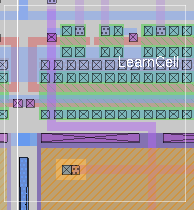



drc option
where option is one of the following:
- catchup
- Run checker and wait for it to complete
- check
- Recheck area under box in all cells
- count
- Count and report error tiles in the edit cell.
- euclidean on|off
- Enable/disable Euclidean geometry checking
- find [nth|text]
- Locate next (or nth) error in current cell; if string text is given instead of an integer, then search for the next error of a type containing the text.
- help
- Print help information
- ignore [text|none]
- Without options, print a list of all rules that are not being reported. With option text, don't report rules containing the string text. This is cumulative; additional calls to "drc ignore text" will add rules to be ignored. Cancel ignoring rules with "drc ignore none" (the default).
- off
- Turn off background checker
- on
- Reenable background checker
- status
- Report whether the background checker is on or off.
- printrules [file]
- Print out design rules in file or to stdout
- rulestats
- Print out statistics about design rule database
- statistics
- Print out statistics gathered by checker
- why
- Print out reasons for errors under box
- *halo [value]
- Without option value, prints out the DRC halo distance, which is the largest distance at which a DRC interaction can occur outside of any area to be checked. Becuase large DRC haloes can cause very long delays in the interactive DRC checks, it can be helpful to use value to force a smaller halo. This causes certain DRC errors to be missed, but allows all the basic short-distance design rules to be checked without undue processing delays.
- *stepsize [value]
- The step size is the length of a side of the area into which the DRC checker routine breaks up larger areas for more efficient processing. Changing this value can greatly effect the speed of the DRC checker, although it is difficult to predict what step size is "optimal". Without option value, returns the current value of the step size.
The Tcl/Tk version of magic defines additional handling with the "list" and "listall" keyword before the option name, indicating that the information be passed back to the interpreter as a list instead of being printed to the terminal window as text.
drc list option
where option is one of the following:drc listall option
- style
- Return the currently active DRC style name to the interpreter.
- count [total]
- Return the DRC error count as a list pair comprising the edit cell name and the total number of errors found. With total, returns just the count as an integer.
- find [nth]
- Return the error description of the next, or nth, error to the interpreter.
- why
- Return the error description of all errors intersecting the cursor box to the interpreter, as a list
where option is one of the following:
- style
- Return a list of all available DRC styles to the interpreter.
- count [total]
- Return the DRC error count as a nested list, where each list item is a pair comprising the cell name of the cell containing the errors, and the total number of errors found. With total, returns only the sum of all the values (probably not very useful).
- why
- Return a nested list containing a detailed description of all errors intersecting the cursor box to the interpreter. In the topmost list, every other entry is the text description of a DRC error class. The list item following the DRC error description is a list of all errors of that type. Each error is presented as a list of four values indicating the bounding box of the error, as {llx lly urx ury} values in internal database units.
The drc command controls the behavior of magic's "background" design rule checker. Normally the design rule checker is invoked whenever the design is changed and checks all parts of the design close to the changed area that might have been affected by the change. The design rule checker flags areas that have been checked as it runs. It starts whenever a layout change has been made or after any command has been executed if areas of the layout still need to be checked. Any macro keystroke in the layout window or command executed on the command line will interrupt the design rule checker pending completion of the action, at which time the design rule checker will be reactivated.The drc on and drc off options are the main controls for starting and stopping the design rule checker. drc status returns the status of the background checker, either "on" or "off". The Tcl version of magic returns a boolean value (0 or 1).
The drc check option marks all areas of the layout under the box as requiring a check and restarts the design rule checker.
The drc why and drc find commands can be used to query errors in the layout discovered by the design rule checker. drc why reports the reason for all error regions found inside the magic cursor box. The drc find command can be used to find errors that may not be visible inside the current window view, or that may be difficult to find on a large layout.
The drc euclidean on command can be useful in cases where vendor design rules intend a Euclidean distance metric (minimum linear distance) rather than a Manhattan distance metric (minimum distance in either the x or y direction, evaluated separately). The default option is "off", as most vendor rules and design rule checkers assume Manhattan distances when checking rules.
The remaining options are relativly obscure and unlikely to be useful to the typical end-user.
drc is implemented as a built-in magic command.

| Return to command index |
Last updated: March 7, 2020 at 1:06pm